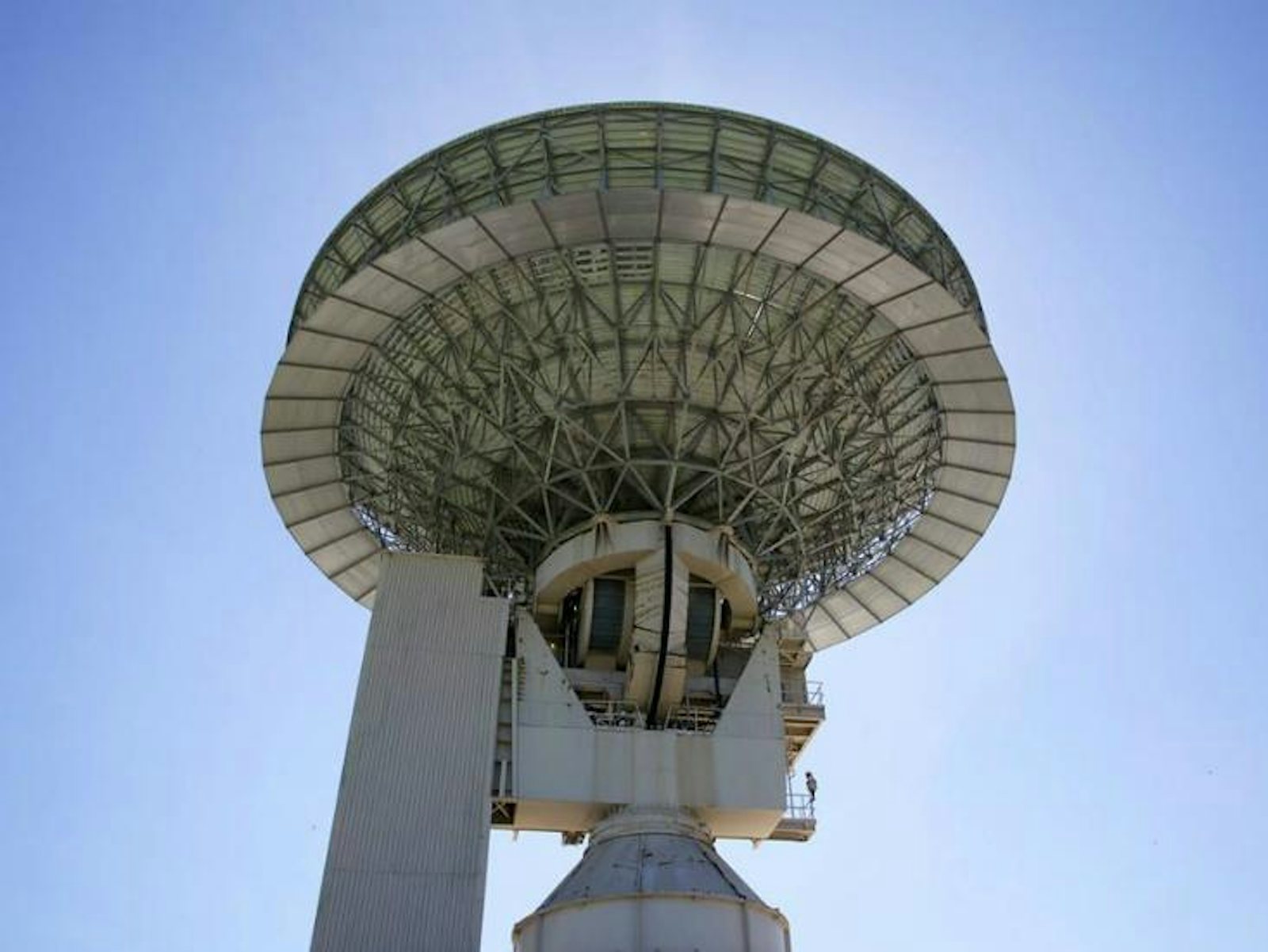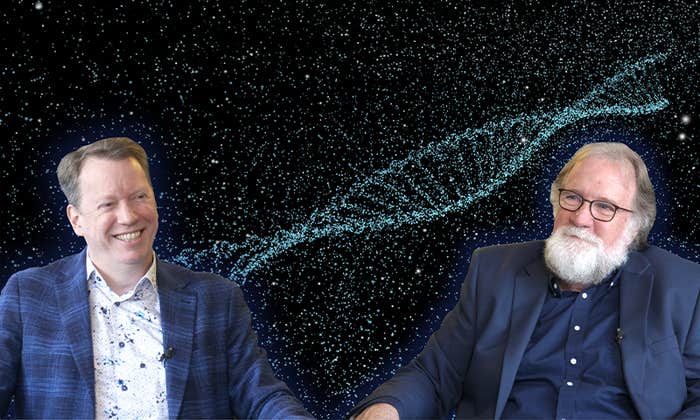“None knows whence creation arose; And whether he has or has not made it; He who surveys it from the lofty skies. Only he knows—or perhaps not.”
This is an edited snippet from a 3,500-year-old Vedic creation myth. I sent each of its 143 characters streaming on a beam of radio waves on June 21, toward a place called Gliese 526, a red dwarf star nestled in the constellation of Boötes some 17.69 light-years from Earth. In early 2031, after traveling 300,000 kilometers in each and every intervening second, my beam will wash over Gliese 526 and any accompanying planets. If someone (something?) in that star system has the right sort of radio telescope pointed at the right region of the sky as my message whispers past, that telescope could detect and record it, perhaps revealing its ancient, cryptic musings about the origins of the heavens and the Earth to an entirely new and alien audience.
Since 1960, a handful of Earthbound astronomers have been using large radio telescopes to ardently (and, so far, fruitlessly) look for any talkative aliens transmitting exactly as I just did. The effort is called SETI, the Search for Extraterrestrial Intelligence, and is relatively uncontroversial: no one sees any harm in listening. The wisdom of transmitting, on the other hand, has been hotly disputed ever since the first major attempt in 1974, when the SETI pioneer Frank Drake used the world’s most powerful radio telescope, the 1,000-foot-wide Arecibo dish in Puerto Rico, to beam a complex message toward M13.
Some SETI practitioners see such METI (Messaging to Extraterrestrial Intelligence) efforts as fraught with danger, since we would be advertising our presence to beings with unknown, potentially dangerous capabilities and intentions. Others argue that an opposition to METI could be why more than half-century of SETI efforts have come up with nothing: If, like some of us down here, everyone Out There is too timid and cautious to transmit to the stars, then we have little hope of ever communicating with other galactic civilizations.
This debate has been somewhat muted by the fact that not just anyone could engage in METI. Now, that’s all changing. To send my message, I didn’t need to build a radio telescope, encode my transmission, or even point it toward my target star. All I did was type in my message and click a few buttons on a website. Lone Signal, a new company that started transmitting on June 18th, did all the rest.
I caught up with Lone Signal’s chief science officer, the astrobiologist Dr. Jacob Haqq-Misra, to ask him to explain how the project works and whether METI is something worth worrying about. A condensed, edited version of our conversation appears below:
Lee Billings: In a nutshell, what is Lone Signal?
Jacob Haqq-Misra: Lone Signal is a messaging platform that allows anyone with an Internet connection to send a message toward star systems selected for our METI (messaging to extraterrestrial intelligence) experiment. Through our website, users can send a 144-character text message for free, and they can send subsequent messages or photos for a fee. The website incorporates aspects of social media that allow users to mirror to Facebook or Twitter, comment on each others beams, make favorites, and view statistics of who else is using the service. The project is made possible by our exclusive access to the historic Jamesburg Earth Station, a 30-meter dish located in Carmel Valley, California. The basic idea behind our METI experiment is to send a beam, containing both a hailing message and a user stream of global messages, toward nearby star systems likely to harbor habitable extrasolar planets.
How does this differ from past projects? The list of transmissions is actually fairly long – the Arecibo Message, the Cosmic Calls, Teen Age Message, Across the Universe, A Message From Earth, Hello From Earth, RuBisCo Stars, the Wow! Reply, and so on. So what’s different about Lone Signal, and should it be considered differently from all these previous efforts? What separates this from just a one-off PR stunt?
There have been many other METI messages, and a lot of them have even used more powerful transmissions than Jamesburg (Arecibo being the most powerful radio transmitter in the world). The main feature that distinguishes our signal from all previous transmissions is that it is a continuous METI experiment, in that we are transmitting more than a single burst over a few minutes or hours. Any watchers near our target will notice our signal as a repetitive pattern that lasts for up to a month and is repeated every year. We are making a concerted effort to start a real long-term METI project now.
Additionally, we are focusing this continuous pattern on the closest stars that are good candidates for hosting habitable planets. That way, the “call and response” time for METI is within a human lifetime—this is also different than most previous METI experiments, which often targeted objects thousands of light years away.
Let’s talk targets and target selection. How do you select them, how big is your list?
Many of the nearby star systems known to harbor extrasolar planets are in the Southern Hemisphere (such as Gliese 581 or Alpha Centauri) and are out of range of the Jamesburg dish. Our targets are therefore nearby stars that are listed on The “Catalog of Nearby Habitable Systems”, or HabCat, which was developed by Margaret Turnbull and Jill Tarter to characterize nearby stars according to their likelihood of hosting habitable terrestrial planets (http://phl.upr.edu/projects/habcat). Gliese 526 is one of the closest stars listed in HabCat that we can also target from Jamesburg. HabCat was compiled before many of the current exoplanet surveys produced results, but the analysis still holds because most exoplanet surveys have targeted faraway, rather than nearby, star systems.
In fact, any of the nearest stars that do have known exoplanets are “hot Jupiter” systems, with very large massive planets orbiting very closely to its parent star—which makes the habitable zone much, much less accessible. Thus, any very nearby stars already known to host planets are probably not good targets for METI. Likewise, if any very nearby stars do have Earth-like habitable planets in orbit, then we would not have observed them yet because we do not have sufficiently sensitive search techniques.
Statistical analyses based upon missions such as Kepler and ground-based exoplanet surveys have concluded that most, if not all, star systems host terrestrial planets in their habitable zones. Following this logic, we have chosen to select the closest potentially habitable systems for our METI experiment (beginning with Gliese 526, but also choosing other targets) based on the assumption that many of these nearby targets will have good candidate planets. These nearby stars are prime candidates for upcoming exoplanet surveys, including ground-based observatories in construction and the planned TESS space telescope.
Finally, low-mass red dwarf stars are the most numerous in the galaxy and also the most long-lived. This makes them extremely attractive targets for exoplanet searches as well as SETI and METI. The habitable zones around these low-mass stars are areas of contemporary research by astrobiologists, and, because they are relatively easier to notice with modern technology, terrestrial planets around red dwarfs will probably be the first potentially Earth-like worlds to be discovered in the near future.
We do plan on targeting new star systems roughly once a month, and we intend on being flexible based on new discoveries.
It’s early yet, but how has the response been so far?
The response has been good so far. Right now the website lists over 5,000 beams sent out, and there have been a lot of people purchasing credits for additional beams. There seems to be a new message posted every few seconds, and we’ve had a lot of different languages, too.
I have to say that I’m most impressed by the diversity in terms of seriousness to randomness. Most people seem to get the idea of communicating something to an extraterrestrial watcher, and a lot of them are of the “get me out of here” theme. Perhaps the strangest I’ve noticed is one user who registered as “Jean-Luc Picard” and has transmitted over a dozen quotes from Star Trek. I think there will be some interesting sociology data mining to be done once this experiment has progressed a little further.
What makes you confident any intelligence, human or otherwise, would be able to recognize the transmissions as messages at all?
Our collaborator Michael Busch has composed a “hailing message,” which is like a “Rosetta stone” that contains a self-defining language that uses physical principles as a common reference point. We think that physics (such as the structure of hydrogen or action of gravity) are the same everywhere in our galaxy, so this is a good way to begin building a language for conversation. As such, the hailing message describes arithmetic and calculus, the periodic table of elements, the structure of some simple molecules, the position of the sun using galactic reference points, and orbital patterns of the planets in our Solar System.
Our main assumption in the hailing message is that any watchers receiving our signal will understand the physics of radio telescopes. Possession of a radio telescope with a large collecting area is needed to detect our signal at interstellar distances, and the ability to build radio telescopes requires a fundamental understanding of mathematics and physics. We also assume that the principles of physics are consistent throughout the galaxy. This allows us to construct a crude mathematical language by using fundamental physical principles as reference points. Any watchers that are technically able to receive our signal will, in principle, also be able to decipher this language.
The hailing message has also been successfully tested on students with a college education in physics, so there is at least some premise for believing that it can be decoded by some. At our signal strength, any watchers orbiting Gliese 526 could detect the Lone Signal transmissions with a dish between 50 meters (for our CW carrier) and 1 square kilometers (for our message carrier) in size.
Do you think the chance for anything receiving these messages is high or low?
The probability of contact with extraterrestrial beings is completely unknown—it could be astronomically low, or it could be astronomically large and we’ve just been exceedingly unobservant. In terms of this specific project, the best we can do is to try and make “call and response” messages that we at least have a chance of trying to listen for a response within a lifetime. SETI has always been a “shot in the dark” with unknown odds and equally unknown rewards.
What do you see as the biggest uncertainties of this undertaking?
The biggest uncertainty for us is whether or not we can make a crowdsourced METI beacon economically viable. Again, this has all been possible based on a single generous donor, and any longevity to this experiment will require the public to take interest and ownership of the project.
An underlying assumption of this project is that any recipients of this message would be benevolent or incapable of somehow responding in a hostile or dangerous manner to the transmissions. Why do you think this is safe and advisable, and what is your response to critics?
Any extraterrestrial watchers observing Earth with radio signals probably already know we are here. If we are really concerned about radio transmissions posing a risk, then we’d have to stop all our radio activities, including television, cell phones, and radar. Furthermore, even our city lights could be detected by a large enough telescope, so we’d have to cease any significant emission of electromagnetic waves to truly hide our presence.
In our recent Space Policy paper [”Benefits and Harms of Transmitting Into Space”], we acknowledge that contact with extraterrestrial beings could be good, bad, or neutral, and we really have no information for deciding which scenarios are more likely than others. However, we propose a working hypothesis that it is better for us to use this technology on Earth (for cell phones, television, radar, city lights) than to become “radio quiet” for fear of extraterrestrial beings. Furthermore, even if we were to enact such a ban, we have already been emitting radio waves for 70+ years
If it’s too late to avoid being detected through our emissions, then what exactly are you trying to achieve? Are you concerned at all about individuals gaming or hijacking the system for ends you don’t agree with?
The hailing message is an important aspect of our METI experiment because it represents an attempt to actually communicate with an unknown watcher. Radar and television signals would look like “noise” to an extraterrestrial watcher—it would let them know that we, a technological civilization, exist on earth, but it would not convey any information. By sending a message that could potentially be understood, we may increase the likelihood of receiving a reply.
We are not concerned with hijackers of the Lone Signal site. If people want to pay to share thoughts beyond their initial message, that’s up to them. Part of the experiment is in sociology with regard to what people find important or meaningful.
Is there any censorship of messages? Can you imagine anything at all you’d prefer not to transmit?
All messages are allowed, although we have a “NSFW” flag to control offensive material. As an experiment open to the public, it is important to us that anyone can send whatever they feel is important.
What are the messages you and the core team members have already personally sent or plan to send? How would you prefer contact to take place if you could dictate that on your own terms?
To me, the most meaningful message we are sending is the hailing message. I mostly like to read the other messages people have sent. It’s actually rather hard to think of a good message—especially if you actually imagine your message being read by an unknown intelligent being! I think radio contact is something we as humans could handle. The discovery of extraterrestrial life will be one of the most significant discoveries of human history, and it will take a lot of time for us to process and decide what to do next. I think it would be also amazing if we happened upon extraterrestrial technology floating around in our Solar System—an extraterrestrial analog to one of our Voyager probes, for example. Even if this were non-functioning and defunct, the discovery of “alien garbage” would be just as exciting as receiving a message from them.
It could be argued that you are not so much trying to communicate with intelligent extraterrestrials as you are trying to communicate with Earthlings who might otherwise be disengaged with the SETI efforts. Is that a fair assessment?
We do hope to discover extraterrestrial beings, but this project is much more about encouraging people to think about their role in the greater universe. We hope to inspire people young and old to think about the space sciences, and we hope to inspire passion especially in the young to perhaps pursue a career in the sciences. Frank Drake put it best when he said “SETI is a search for ourselves”, and the same is true of our efforts to engage the world in thinking about METI.
Lee Billings is a freelance writer living in New York City. Five Billion Years of Solitude, his book on the search for Earth-like exoplanets, will be published this October by Current/Penguin.


























